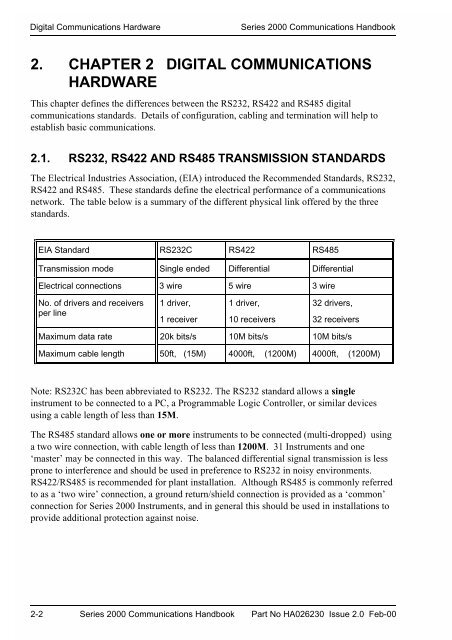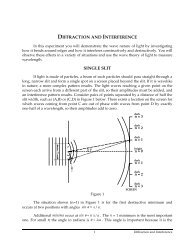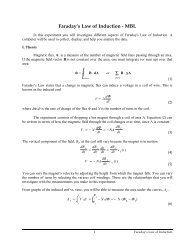Series 2000 Communications Handbook
Series 2000 Communications Handbook
Series 2000 Communications Handbook
Create successful ePaper yourself
Turn your PDF publications into a flip-book with our unique Google optimized e-Paper software.
Digital <strong>Communications</strong> Hardware<strong>Series</strong> <strong>2000</strong> <strong>Communications</strong> <strong>Handbook</strong>2. CHAPTER 2 DIGITAL COMMUNICATIONSHARDWAREThis chapter defines the differences between the RS232, RS422 and RS485 digitalcommunications standards. Details of configuration, cabling and termination will help toestablish basic communications.2.1. RS232, RS422 AND RS485 TRANSMISSION STANDARDSThe Electrical Industries Association, (EIA) introduced the Recommended Standards, RS232,RS422 and RS485. These standards define the electrical performance of a communicationsnetwork. The table below is a summary of the different physical link offered by the threestandards.EIA Standard RS232C RS422 RS485Transmission mode Single ended Differential DifferentialElectrical connections 3 wire 5 wire 3 wireNo. of drivers and receiversper line1 driver,1 receiver1 driver,10 receivers32 drivers,32 receiversMaximum data rate 20k bits/s 10M bits/s 10M bits/sMaximum cable length 50ft, (15M) 4000ft, (1200M) 4000ft, (1200M)Note: RS232C has been abbreviated to RS232. The RS232 standard allows a singleinstrument to be connected to a PC, a Programmable Logic Controller, or similar devicesusing a cable length of less than 15M.The RS485 standard allows one or more instruments to be connected (multi-dropped) usinga two wire connection, with cable length of less than 1200M. 31 Instruments and one‘master’ may be connected in this way. The balanced differential signal transmission is lessprone to interference and should be used in preference to RS232 in noisy environments.RS422/RS485 is recommended for plant installation. Although RS485 is commonly referredto as a ‘two wire’ connection, a ground return/shield connection is provided as a ‘common’connection for <strong>Series</strong> <strong>2000</strong> Instruments, and in general this should be used in installations toprovide additional protection against noise.2-2 <strong>Series</strong> <strong>2000</strong> <strong>Communications</strong> <strong>Handbook</strong> Part No HA026230 Issue 2.0 Feb-00





